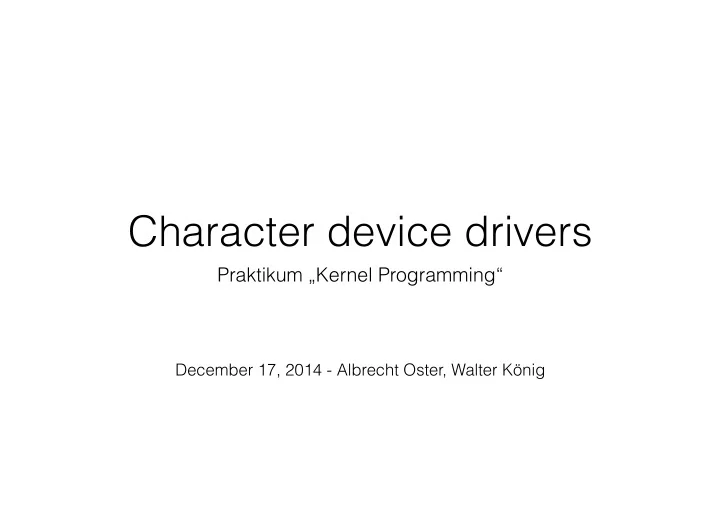

Character device drivers Praktikum „Kernel Programming“ December 17, 2014 - Albrecht Oster, Walter König
Outline • What is a character device driver? • How can we use it? • What does it look like? • Let’s write our own! 2
What is a character device driver? • two common types: character devices and block devices • character devices are byte-oriented • transfers a stream of bytes directly from kernel to user space • unbuffered and synchronous access • basic I/O (real serial devices, virtual devices) 3
Examples for character devices • most common type of device driver • is represented as a device file (e.g. /dev/ttyS0 ) • can be used like a regular file from user space • open, read, write, close 4
How does it fit in the Linux architecture? • remains in kernel space • used by user space apps through the device file in the VFS • usual file operations • outcome may differ • the driver has final low level access to the actual device 5
How does it fit in the Linux architecture? • four entities involved • user space app • character device file (virtual file system) • character device driver (kernel space) • actual character device 6
Loading / Unloading • module_init(function_ref) • module_exit(function_ref) • insmod loads the driver • rmmod unloads the driver 7
Registering a device file • devices are referred to by major and minor numbers • int register_chrdev(unsigned int major, const char *name, struct file_operations *fops); • driver is registered to one major number several instances of the same driver are distinguished by minor • numbers can define file operations it supports • 8
ioctl • represents a way to control the device itself • every device can have its own ioctl commands • defined in file operations struct • used by a user space app with a file descriptor and macro from header files • int ioctl(int file_handle, int request, char *data); 9
• blocking I/O • restricting access to the device • single-user lock • system-wide lock • „device busy“ 10
Literature • „Character Device Drivers“ http://linux.die.net/lkmpg/x569.html • „Enhanced Char Driver Operations" http://www.xml.com/ldd/chapter/book/ch05.html • Wikipedia: „Device File“ http://en.wikipedia.org/wiki/Device_file • „Decoding Character Device File Operations" http://www.opensourceforu.com/2011/05/decoding-character-device-file-operations/ • „I/O Control in Linux“ http://www.opensourceforu.com/2011/08/io-control-in-linux/ • „Mknod" http://linuxwiki.de/mknod 11
Recommend
More recommend